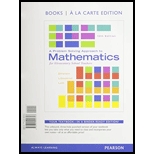
Concept explainers
ASSESSMENT
Write each of the following in the simplest form or as
a.
c.
Want to see the full answer?
Check out a sample textbook solution
Chapter 8 Solutions
A Problem Solving Approach to Mathematics for Elementary School Teachers, Books a la Carte Edition plus NEW MyLab Math with Pearson eText - Access Card Package (12th Edition)
- (ii)arrow_forward16. Pseudo-Inverses • Define the Moore-Penrose pseudo-inverse of a matrix. Prove that the pseudo-inverse exists for any matrix. Compute the pseudo-inverse of: 1 2 G 3 26arrow_forward24. What is the value of ¿4, where i 25. Simplify log2(8). = −1? 2x25x10, find P(2). 26. If P(x) = x³- 2x² + 5xarrow_forward
- 1. Existence and Uniqueness Theorem State and prove the Picard-Lindelöf theorem for the existence and uniqueness of solutions to first-order ordinary differential equations. Consider the differential equation y' = y²+x. Analyze the conditions under which the existence and uniqueness theorem is valid.arrow_forwardi need help pleasearrow_forwardA convex polygon is said to be regular if all of its sides have the same length and all angles between sides are the same. Let Pr denote the regular convex n-sided polygon. Thus, P3 is the equilateral triangle, P₁ is the square, P is the pentagon etc. Compute a formula for the size of any internal angle of Pn.arrow_forward
- + Recall that a map, f: R2 R², is an isometry if |P-Q| = |ƒ(P) — ƒ (Q) for all pairs of points P and Q in R². Thus, f is a distance preserving map. Show that an isometry, f: R² → R² also preserves angles. In other words if two line segments meeting at a point determine an angle a, their image line segments meeting at the image of that point also determine the angle a.arrow_forwardUsing Harriott's formula for the area of a triangle on the unit sphere, S2, compute the Euler characteristic X(S2). Make sure to explain what the Euler characteristic is. (The point of the exercise is to show that this notion is well-defined.)arrow_forwardProve Harriot's Formula (Area of a Triangle on a Sphere).arrow_forward
- 6. (i) Sketch the trace of the following curve on R², (t) = (sin(t), 3 sin(t)), tЄ [0, π]. [3 Marks] Total marks 10 (ii) Find the length of this curve. [7 Marks]arrow_forwardhelppparrow_forward7. Let F(x1, x2) (F₁(x1, x2), F2(x1, x2)), where = X2 F1(x1, x2) X1 F2(x1, x2) x+x (i) Using the definition, calculate the integral LF.dy, where (t) = (cos(t), sin(t)) and t = [0,2]. [5 Marks] (ii) Explain why Green's Theorem cannot be used to find the integral in part (i). [5 Marks]arrow_forward
 Algebra: Structure And Method, Book 1AlgebraISBN:9780395977224Author:Richard G. Brown, Mary P. Dolciani, Robert H. Sorgenfrey, William L. ColePublisher:McDougal Littell
Algebra: Structure And Method, Book 1AlgebraISBN:9780395977224Author:Richard G. Brown, Mary P. Dolciani, Robert H. Sorgenfrey, William L. ColePublisher:McDougal Littell Holt Mcdougal Larson Pre-algebra: Student Edition...AlgebraISBN:9780547587776Author:HOLT MCDOUGALPublisher:HOLT MCDOUGAL
Holt Mcdougal Larson Pre-algebra: Student Edition...AlgebraISBN:9780547587776Author:HOLT MCDOUGALPublisher:HOLT MCDOUGAL Glencoe Algebra 1, Student Edition, 9780079039897...AlgebraISBN:9780079039897Author:CarterPublisher:McGraw Hill
Glencoe Algebra 1, Student Edition, 9780079039897...AlgebraISBN:9780079039897Author:CarterPublisher:McGraw Hill
 College Algebra (MindTap Course List)AlgebraISBN:9781305652231Author:R. David Gustafson, Jeff HughesPublisher:Cengage Learning
College Algebra (MindTap Course List)AlgebraISBN:9781305652231Author:R. David Gustafson, Jeff HughesPublisher:Cengage Learning Mathematics For Machine TechnologyAdvanced MathISBN:9781337798310Author:Peterson, John.Publisher:Cengage Learning,
Mathematics For Machine TechnologyAdvanced MathISBN:9781337798310Author:Peterson, John.Publisher:Cengage Learning,





